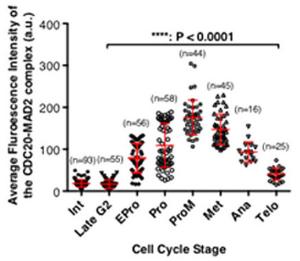News
New paper from Jun-yong's lab

The kinetochore-dependent and -independent formation of the CDC20-MAD2 complex and its functions in HeLa cells
Jianquan Li, Nanmao Dang, Daniel James Wood & Jun-Yong Huang
Scientific Reports 7, 41072 (2017)
Abstract
The mitotic checkpoint complex (MCC) is formed from two sub-complexes of CDC20-MAD2 and BUBR1-BUB3, and current models suggest that it is generated exclusively by the kinetochores after nuclear envelope breakdown (NEBD). However, neither sub-complex has been visualised in vivo, and when and where they are formed during the cell cycle and their response to different SAC conditions remains elusive. Using single cell analysis in HeLa cells, we show that the CDC20-MAD2 complex is cell cycle regulated with a “Bell” shaped profile and peaks at prometaphase. Its formation begins in early prophase before NEBD when the SAC has not been activated. The complex prevents the premature degradation of cyclin B1. Tpr, a component of the NPCs (nuclear pore complexes), facilitates the formation of this prophase form of the CDC20-MAD2 complex but is inactive later in mitosis. Thus, we demonstrate that the CDC20-MAD2 complex could also be formed independently of the SAC. Moreover, in prolonged arrest caused by nocodazole treatment, the overall levels of the CDC20-MAD2 complex are gradually, but significantly, reduced and this is associated with lower levels of cyclin B1, which brings a new insight into the mechanism of mitotic “slippage” of the arrested cells.
Last modified: Tue, 15 Aug 2017 12:41:58 BST